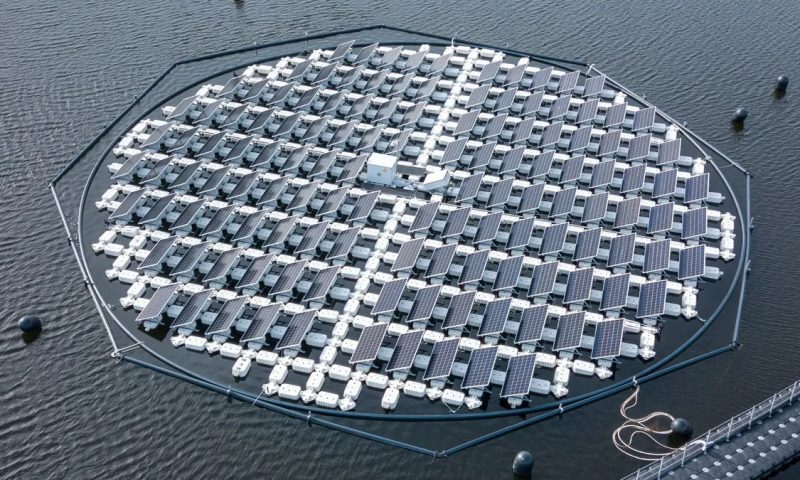
A Portuguese company’s innovative floating solar panels stalk the Sun’s movements
Currently floating on a lake in the Netherlands, the solar island comprises 180 movable solar panels that provide an increase in energy production by up to 40 percent.
A Portuguese company’s sustainable solution is following the Sun, almost like a stalker, in a bid to get the most out of its energy.
SolarisFloat has developed an innovative floating solar solution that is unlike the many being installed in water bodies around the world. With single- or dual-axis tracking, the floating island is powered by electric engines that consume less than 0.5 percent of the total energy produced. As the BBC explained, the installation, named PROTEVS, is the first to merge floating solar panels with Sun-tracking technology.
The island is currently floating in Oostvoorne Meer, a lake in the southwest Netherlands. Comprising 180 mobile solar panels, PROTEVS has a total installed capacity of 73 kilowatts of peak power (kWp) and provides an increase in energy production by up to 40 percent, thanks to its sophisticated technology that permits its double-sided panels to turn according to the Sun’s movement.
The detachable panels could merge into a solar farm
The company offers two types of solutions. The first is the PROTEVS+, which features 180 modules with dual-axis tracking. The same as the project mentioned above, it has a diameter of 38 meters and occupies an area of 1,444 square meters. The panels move vertically.
The second solution is the PROTEVS Single360, which works on a single axis. It has PV modules on a fixed slope of 10 degrees and features 360 modules. Protevs Single360 has an installed capacity of 147 kWp for 410 W panels.
According to Solaris Float, the PROTEVS solutions are modular, detachable, and scalable, with an easy installation process. As they can be detached, the islands can even be merged to form a floating solar farm.
The sun-tracking panels help save space
According to Popular Science, sun-tracking solar farms come with limitations. The location is the first. Considering Proteus’ systems, they won’t be efficient near the Equator as the panels will stay horizontal the whole day. They will also need to be installed in places with weaker tidal currents.
Nevertheless, such floating solar farms can be largely beneficial in the long run – especially considering the space needed to set up solar farms. Popular Science referenced a study from Leiden University in The Netherlands that estimated the area that solar farms need – which is, turns out, some 40-5 times the area of coal plants, and 90-100 times the land required by gas providers. Therefore, floating solar farms are definitely an effective way to allow space for other projects that can help tackle climate change.
Reduces the rate of water evaporation
These solar floating farms, according to the company, goes above and beyond the precedented environmental impact.
The shadows formed in the floating structure and PV panels, resulting in a “superficial” temperature reduction, which is beneficial to the aquatic ecosystem. SolarisFloat claims a 60 percent reduction of evaporation in the body of water.
Secondly, the water quality is likely to increase due to the reduction of algae, and the reproduction of other micro-organisms, which can take place due to the aforementioned shadowing effect. This can be further enhanced by the installation of water-oxygenating equipment.








